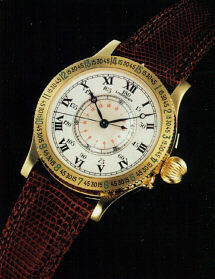
 |
The first watches were glittery improvisations- small timepieces affixed to the wrist of the wearer (always a woman) with jeweled bracelets or decorative ribbons. Empress
 A replica of the 1931 hour angle "Lindbergh" watch by Longines A replica of the 1931 hour angle "Lindbergh" watch by Longines |
 Tonneau shaped diamond watches from Vacheron Constantin |
Whatever its origin, the wristwatch remained an ornamental novelty until the military adopted it in the late 19th century. World War I made wristwatches truly popular for the first time, as soldiers who had worn them during combat returned home and brought a new taste for easy time-telling with them. Around 1920, the wristwatch became a commercial product, and since then, watch styling has been in a continual state of change.
The period through the 1920s was a time of experimentation, when watch manufacturers, exploring a new kind of product, were unhindered by established ideas about what it should look like. out of such a free-wheeling atmosphere came such design features as exaggerated, illegible Arabic numerals, unusual shapes, including elongated rectangular or tonneau cases, mixtures of yellow and white gold and lots of art deco detail. Dials in the 1920s were often porcelain.
The "anything goes" mentality of the glitzy 1920s gave way to simpler design in the '30s, bordering sometimes on the severe. Enameling and other kinds of decoration all but disappeared, and design was cleaner and more streamlined. The rectangular movement first appeared in the 1930s, designed to fit the tank shapes which now dominated men's watch design. Previously, round movements had been fitted in all cases regardless of shape. It was also during the 1930s that another development, lugs with replaceable pins, came into use. Arabic numerals, almost exclusively, were used on watch dials.
War once again affected the world of watch design in the 1940s, when European and military influences showed up frequently. It was during this decade that the 24-hour dial came into vogue. The chronograph, which had appeared on pocket watches in the 18th century, became a frequent addition to wristwatch faces after World War II, and remained so until about 1960.
The 1940s also brought a revived interest in ornament. Bizarre shapes, scrolled lugs and even patterned dials appeared in some models. Pink-gold dials, a carryover from the late 1930s, remained in use during the 1940s.
In the 1950s, technology took the upper hand in watch design. Several major watch companies started to manufacture versions of automatic, or self-winding, watches, which had been invented by John Harwood in the 1920s and improved upon by Rolex in 1931.
The decade also brought the short-lived electric watch, introduced by Hamilton. The most
 |
| Above: two dress watches from Van Cleef & Arpels |
Hamilton was not the only company to take a breakaway attitude toward design in the '50s. Many companies introduced unusual, often Metrically shaped watches. Numerals practically disappeared from watch faces, giving way to indexes. By 1960, technological improvements had made shallower cases possible, and thinness was established as an ideal in watch design.
The prevalent theme of the '60s was simplicity. indexes remained far more popular than numerals; faces, bezels and lugs were as straightforward as possible. The only adornment was often a date window. Cases were most often round. Metal bracelets became more popular as the decade wore on.
The '70s started with the launch of quartz technology, which brought with it some dramatic design changes. The biggest one: the appearance of the digital display. During the decade the digital watch evolved from a conversation piece and status symbol to a watch department staple.
Quartz also enabled companies to make analog watches slimmer and more elegant-looking than ever before. Swiss firms became engaged in a "thinness war" which culminated in the tank-shaped Concord Delirium, just 1.98mm thick, in 1979. Steel gained new respectability as a material for expensive watches, due in large part to the success of Audemars Piguet's Royal Oak watch, introduced in 1972.
The '80s were the most fertile decade yet for watch design, with a broader range of ideas influencing it than ever before. The launch of the zany, whimsical Swatch in 1983 set off an explosion in demand for inexpensive fashion watches which continues to this day. The rise of the vintage watch market brought a revival of retro styles. New models featuring subdials, tank shapes and porcelain-white dials with Roman numerals (many of them reproductions of actual old watches) brought the styles of the '30s,'40s and '50s into the present. The chronograph reappeared after an absence of 30 years or so, and suddenly chunky, masculine watches covered with complex numerical scales, push buttons and extra hands were the most chic thing around. Rugged sports watches also proliferated.
The '90's have so far seen a continuation of the many trends born in the prior decade. One big change: Women's watches have taken on a new importance. Manufacturers are bringing out a plethora of jeweled dress models and versions of complicated men's watches scaled down for women's wrists. Another difference: Slim dress watches for men, overshadowed during the chrono craze of the late '80s. are coming into the spotlight once again.